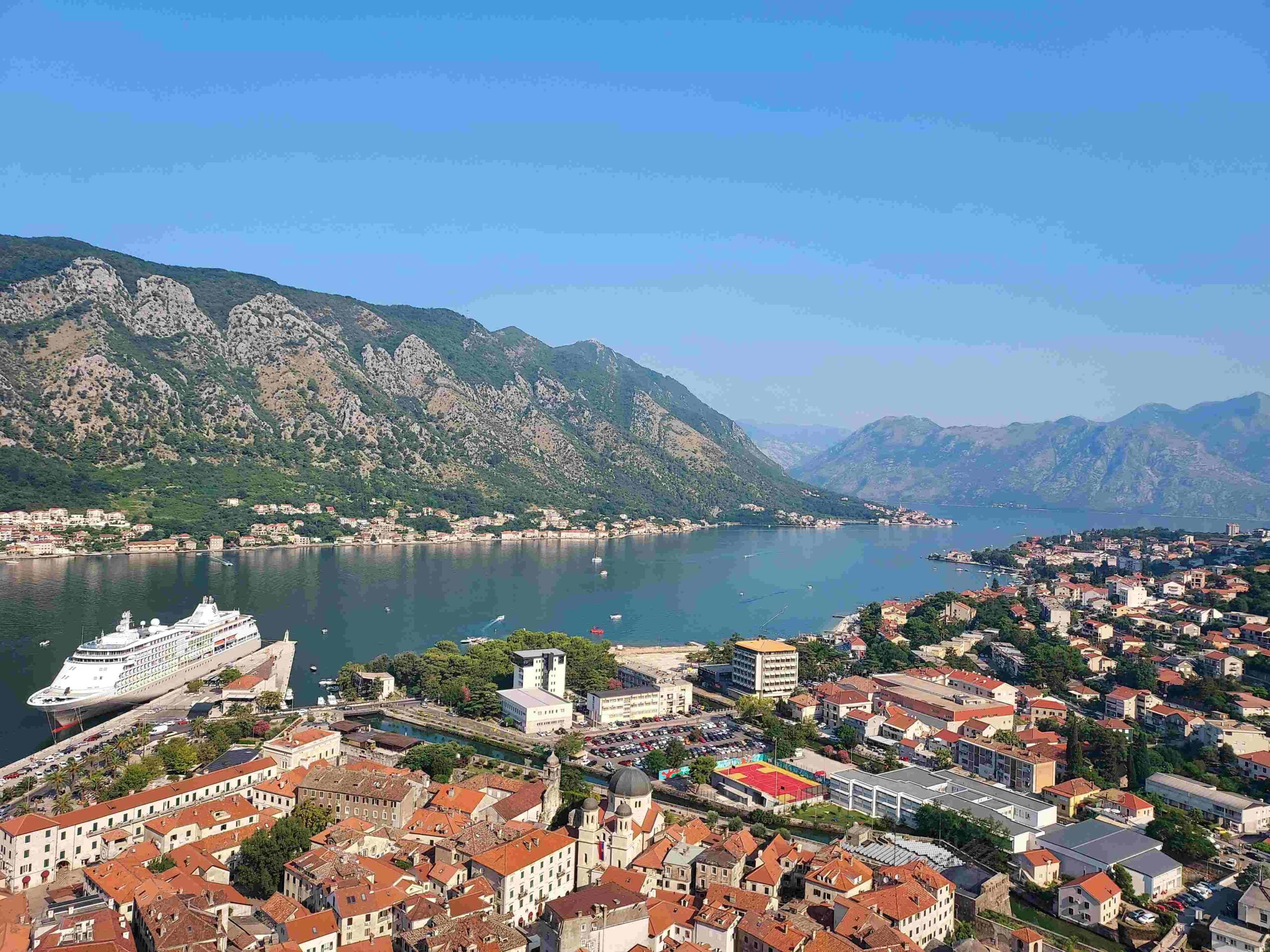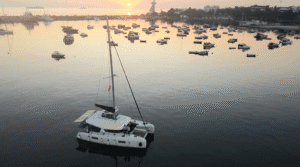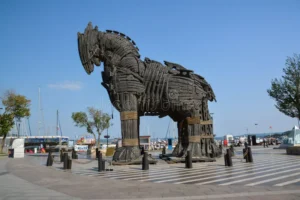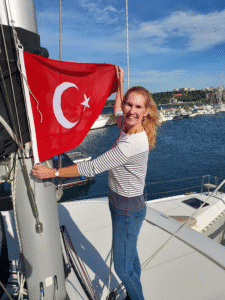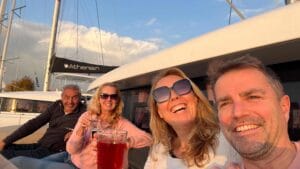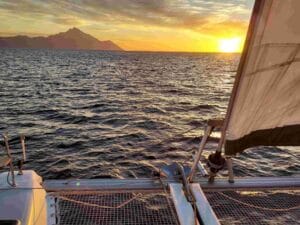After our experience of sailing in Venice, we sailed south along the coast of Croatia where we had been sailing for 4 months. We visited places we skipped on our travels then in Croatia and could now visit on our way south. Our aim was to arrive in Dubrovnik, where we started our adventure sailing Croatia end of February.
Our goal was to check out of Croatia at Customs in Dubrovnik (Croatia is not a Schengen nation), see the pictures below. The Q means you are in Quarantine for the period that they check your papers and give you a stamp in your passport.


Then we sailed into Montenegro (1 hour away), at the pier of Zelenika, see below. Also checking in there and then we were allowed to stay in Montenegro with our sailboat, so hoist the red/golden Montenegro flag!



This is the route that we sailed in Montenegro and along the coastline of Montenegro, in this blog you will read part 1 about Herceg Novi, The Bay of Kotor with Lady of the Rock, Perast and the city of Kotor:

5 facts about Montenegro
It’s an interesting country that we didn’t know much about, but we learned about during our sailing trip. People, like in Croatia, are friendly, their English is less developed then in Croatia because it just recently got popular among tourists, since about 5 years. Prices are still relatively cheap for us Europeans and the amount of sailing boats is not as many in comparison to Croatia.
- Montenegro became independent in 2006, when it declared its secession from the union with Serbia
- It borders 5 countries: Croatia, Bosnia and Herzegovina, Serbia, Kosovo and Albania
- The highest mountain in Montenegro is Bobotov Kuk. The peak of this mountain is 2,523 meters.
- Montenegro’s coastline is 293 kilometers long (Croatia is 1800 kilometers long)
- Since 1990, Montenegro used the Yugoslav dinar as its official currency, like the rest of the then Federal Republic of Yugoslavia. After the fall of Yugoslavia and the hyperinflation of the 1990s, Montenegro decided to use the German mark (DEM) as it’s currency in 1999, although it was still formally part of the federation with Serbia. When the euro replaced the German mark in 2002, the euro (EUR) became the official currency of Montenegro, despite the country not being an official member of the eurozone.
Herceg Novi
We first visited Herceg Novi, a cozy place on the western part of Montenegro. We parked the boat in a little harbor with a lot of little boats and we enjoyed a nice sunset here the first evening.

And to our surprise, this harbor had a Olympic size swimmingpool! It turned out that the most popular sport in Montenegro is waterpolo.We visited a game, we didn’t know the rules but we learned it quickly: 7 players per team, playing time consists of four periods of 8 minutes of pure playing time each (the clock is stopped when the game is interrupted). There is a short break between the periods: 2 minutes. The field is 30 meters long and 20 meters wide. A team has 30 seconds to make an attempt on a goal. If this is not successful, the ball goes to the opponent.


Herceg Novi has a unique blend of Mediterranean (especially Venetian) and Ottoman influences. We enjoyed walking around.




We were surprised about the old city center and also about the hip and trendy beach around the corner!

The reason why we stayed a few days in Herceg Novi, was to welcome our friends from Luxembourg! We have known them since 2018, when we happened to rent a cabin together on a catamaran in Greece. For us, it was the start of discovering the best boat for our world trip and it was a holiday trip for the Luxembourgers: father Joe, mother Birgid, son Mortiz and daughter Anna. We enjoyed each other’s company, so in 2019 we all booked another week on a catamaran together, this time in Mallorca. And in 2020 we were able to invite them to sail with us on our own catamaran ;). They have since sailed with us in Denmark, Northern Spain and now in Montenegro.
Son Moritz was not there this time, but four people came and that also had a Dutch touch! Anna has been studying Theatre and Music at Fontys University of Applied Sciences in the Netherlands in recent years and brought her good friend Kevin with her. They graduated this year and already have great roles: Anna in Les Misérables in Germany and Kevin in Award Winning Musical 2024 Jesus Christ Superstar, followed by the musical ‘Elisabeth’ this fall.


It was a warm reunion, and for Kevin the first time on a catamaran! We bought them a present for their graduation: 2 bath towels to enjoy on the boat now and later during holidays!
Bay of Kotor
We all were very much looking forward to sail into the Bay of Kotor, the world famous lake in Montenegro.
The Bay of Kotor, also called the “Fjord of the Mediterranean”. A river valley that has been carved out by glaciers over the centuries and then flooded by the sea. The Bay is 60 meters deep in some places and has an area of 87 km² from the entrance at the Strait of Verige to the town of Kotor. In some places the bay is only a few kilometers wide, which offers spectacular views of the surrounding high mountains.

The Bay of Kotor was declared a UNESCO World Heritage Site in 1979. This is because of the unique combination of natural beauty and cultural history dating back to ancient times.

We visited a lot of places in the Bay and these 4 I like to highlight:
1. Lady of the Rock
In the middle of the Bay, and that was of course the thing that caught our attention, there is a small artificial island with the famous Lady of the Rock (Gospa od Škrpjela) on it. This island is unique, because it was created by human hands by sinking rocks and old ships full of stones at this location. Legend has it that two fishermen brothers found a painting of the Virgin Mary here and decided to build a church on this holy spot.


But first we had to swim, so we dived into the water and inspired by water polo, we had bought a small ball in Herceg Novi that we could throw around in the water and that would float.
Still, we were curious about the island (the Rock) and the church on it (Lady, see below on the left), but we also saw that it was so difficult to moor there with a catamaran. So we got on the paddleboard out and joined with 4 people, by the way it is suitable for 2 people ;), and then paddled our way to the island and walked around there!


The church that stands here today was built in the 17th century and is filled with beautiful frescoes and maritime artifacts left by sailors in gratitude for a safe crossing. After the visit, we then had to go back again on our paddleboard!

2. Kotor
Then we sailed to another highlight of the bay: the city of Kotor. Here we are swimming in the water in front of the old city. And why another swimming photo? The temperature on the picture on the right was the reason why we anchored at least 3 times a day to cool down by swimming!

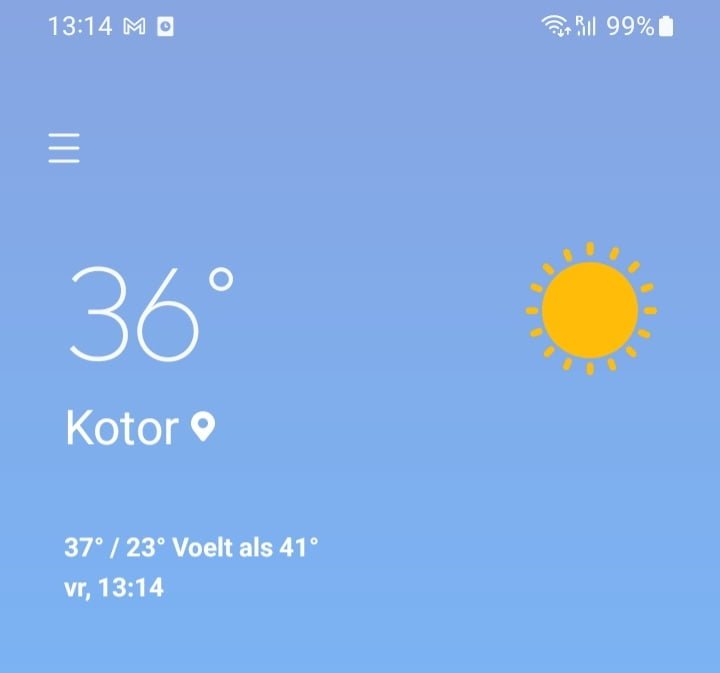
We had not really delved into the historical Kotor. It turned out to be one of the best preserved early medieval cities in the Adriatic region. The narrow, winding streets take you past impressive buildings, squares and churches.




In the evening a BBQ on the boat, where captain Gilles changed into Grilles and made his famous Indonesian satay, made from the good meat we bought at a butcher’s shop in Montenegro.
3. Climbing the Castle of Kotor
If you look closely at the BBQ evening photo, in the background you will see a series of lights in the middle, climbing up. And that is exactly what it is: a climb, to a castle. Because the most breathtaking thing about Kotor is without a doubt, the old city wall that winds high up the mountain to the Castle of San Giovanni, an absolute must.
The climb consists of no less than 1,350 steps, which zigzag up the steep mountainside. Anna and Kevin wanted to do the climb, starting at 8:00 in the morning, because it is then already 28 degrees, but not yet 36 degrees…. I will turn 50 years this year, which is the ages of Anna and Kevin added together (24+26), so I wanted to challenge myself to climb up with these youngsters!
Here we started the climb, it is an impressive defense line of about 4.5 kilometers long, often 20 meter high walls and in some places even 15 meters wide.


Construction began in the 9th century and was further expanded and strengthened, especially under Venetian rule from the 15th century onwards. The Venetians saw the strategic value of Kotor as a defensive post on the Adriatic Sea to protect the city from attacks from the Ottoman Empire, especially at that time.


It was great fun and ultimately not too bad climbing, because there were so many fun facts, buildings along the way and beautiful viewpoints where we stopped, that we reached the top relaxed. From the top you are rewarded with a panoramic view of the city and the entire bay – a view I will never forget!




4. Perast
We sailed away from the city of Kotor, towards the exit of the Bay where we also had entered. But on the way there was another important stop, near Lady of the Rock: the town of Perast.
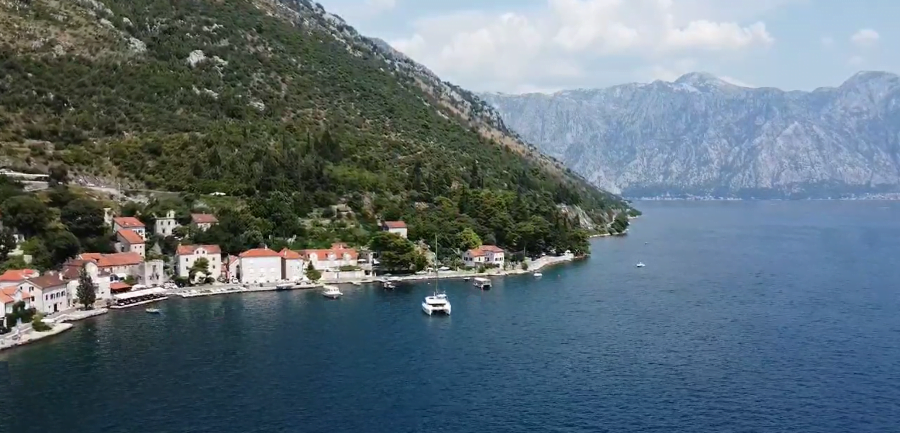
Perast is small and car-free, which contributes to the serene and historical atmosphere. The narrow streets and baroque buildings give you the feeling that you have gone back in time.

Perast is known for its beautiful baroque buildings, mostly built by wealthy sea captains in the 17th and 18th centuries. These houses still retain their original charm.


The promenade along the water is dotted with cozy cafes and restaurants, where you can enjoy the view of the bay and the surrounding mountains.


Of course we wanted to capture this beautiful view with our drone! Watch the images from the catamaran on Perast, flying over Perast and of course we ended with swimming in the Bay, which can also be seen in the video:
However, there is a tragic history behind Perast, exactly 400 years ago, 1624.
In the 17th century, Perast was a prosperous city with a strong maritime fleet. On June 22 in 1624, in the evening a fleet of 15 ships sailed into the Bay of Kotor, with 2,000 pirates from Tunisia and Algeria aboard. They sailed past Herceg Novi, which was already in the hands of the Ottomans and went to Perast which was owned by the powerful Venice, far away though…..
Many men were at sea fishing that evening and the village was not resistant to the attacks, with looting of houses and churches. 415 people died and a large number of inhabitants were captured, especially women and children. They were taken hostage and taken away as slaves.
The remaining population refused to surrender and stayed in their homes, selling their possessions to buy back the hostages. They kept doing this for the next years. After that, the village was poor, but continued to be attacked by pirates from North Africa, specifically the Ottoman Barbary pirates.
The resilience and pride of the people of Perast was never defeated and they gradually rebuilt their town in the following century. The ties with Venice grew stronger, and the town built an even stronger fleet to fend off future attacks. It remained an important maritime centre in the 18th century, Perast sea captains were famous for their skills and were often deployed in Venetian expeditions.
Part 2 – Montenegro
There was so much to see in Montenegro, that I needed to write another blog about it! So next blog, part 2 of Montenegro is about the southcoast of Montenegro including beautiful cities like Budva and Bar, and what is known as ‘Hawaii beach’. We made a Mamma Mia sailing movie and we were left all alone in a restaurant: the staff went home trusting us to close the restaurant!
